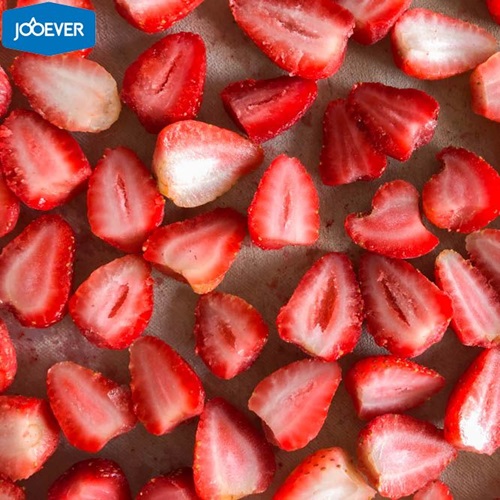Your reliable partner for frozen foods
Freezing strawberries is one of the best ways to extend their usability without losing too much flavor, texture, or nutrition. For both home cooks and food professionals, frozen strawberries are convenient and versatile—ready to use in smoothies, desserts, sauces, and more. But how long can you really keep them in your freezer before quality starts to drop? And how do you know when it's time to toss them out? This guide walks you through everything you need to know about storing frozen strawberries properly and making the most of their shelf life.

Several key factors determine how long frozen strawberries can last before their quality declines. While most people assume freezing means indefinite preservation, the reality is more nuanced. Time, temperature, packaging, and processing method all play important roles in determining longevity.
Strawberries that are flash-frozen right after harvest generally last longer and better retain their color and texture. These are often referred to as IQF frozen strawberries—individually quick frozen—which ensures each berry is preserved in its optimal state without clumping together. In contrast, berries frozen at home after sitting in the fridge for days may not store as well due to initial moisture loss or microbial exposure.
Another factor is freezer temperature stability. A freezer that fluctuates around the 0°F (-18°C) mark may cause partial thawing and re-freezing, which damages cell structure and leads to mushy, frost-covered fruit. On the other hand, deep freezers that stay consistently below freezing offer a much more stable environment, reducing the risk of freezer burn.
Packaging also plays a critical role. Commercially vacuum-sealed bags or moisture-resistant pouches extend life by preventing air exposure. At home, loose packing in unsealed containers allows moisture loss, ice crystal formation, and oxidation. Even the presence of small air gaps in the bag can lead to gradual texture degradation and off-flavors.
In short, the better the initial freezing process and the more stable your storage conditions, the longer your strawberries will last—and the better they'll taste when you finally use them.
When stored properly, frozen strawberries can last a surprisingly long time—but that doesn't mean they stay perfect forever. Most commercially frozen strawberries have a recommended shelf life of 12 to 18 months. This window assumes consistent storage at or below 0°F and sealed packaging. Within this timeframe, the fruit retains most of its color, flavor, and texture, especially if it was flash-frozen using the IQF method.
For home-frozen strawberries, the shelf life tends to be shorter, often around 6 to 12 months. This is because home freezers typically open and close frequently, introducing temperature fluctuations. Homemade freezing methods also tend to involve more exposure to air, which can lead to frost build-up and flavor degradation over time.
While it's technically safe to eat strawberries frozen for longer than 18 months, the quality may be poor. You may notice the berries become dry, discolored, or bland. Their structure breaks down and they turn mushy once thawed, which limits their use in recipes where texture matters.
Labeling your containers with the date of freezing is a good practice. It helps you use the older batches first and keeps your inventory organized. If you're freezing strawberries regularly—whether from a garden harvest or bulk buying—it's especially important to rotate your supply and avoid stockpiling past-prime fruit that won't taste its best.
Ultimately, while frozen strawberries don't spoil the same way fresh ones do, their quality definitely has a time limit. Recognizing that limit ensures you're enjoying them at their best, not just avoiding waste.

Storing frozen strawberries the right way can significantly extend their quality and usefulness. If you're freezing strawberries at home, or if you want to make sure your store-bought ones stay in top shape, there are a few key things to keep in mind.
First, packaging is critical. Strawberries should be stored in airtight, moisture-resistant containers or freezer-safe zip-top bags with as much air removed as possible. If you're preparing them yourself, consider using a vacuum sealer—it minimizes air exposure and drastically reduces the risk of freezer burn. If you're re-sealing a bag that was opened, pressing out excess air and sealing it tightly can make a big difference.
Temperature consistency is another factor. A standalone chest freezer usually performs better than the freezer compartment of a refrigerator. That's because it's opened less frequently, which means the temperature remains stable and the strawberries stay fully frozen. Avoid storing strawberries near the freezer door, where they're more likely to thaw slightly every time the door is opened.
Portion control is also a helpful strategy. Freezing strawberries in single-use quantities avoids repeated thawing and re-freezing. For example, you might portion out one-cup servings in individual bags, ready to go into a smoothie or recipe without needing to open a larger package.
Finally, label everything. Include the freezing date and, if you have a large batch, the source or type of strawberry. This helps you use older berries first and avoid any surprises when you defrost them months later.
With these simple habits, you can maximize the storage life of frozen strawberries and minimize both waste and disappointment.
Unlike fresh fruit, frozen strawberries don't mold or rot in the traditional sense, but that doesn't mean they're immune to deterioration. Over time, they can lose flavor, change color, or develop textures and smells that make them less than ideal for use. Recognizing these signs can help you avoid unpleasant surprises.
One of the first indicators is freezer burn. This appears as whitish or grayish patches on the fruit where moisture has escaped and ice crystals have formed. While not dangerous, freezer-burned strawberries tend to be dry, woody, and flavorless. They're still usable in cooked sauces or baking, but less appealing in fresh applications like smoothies or yogurt bowls.
Another common issue is excessive ice buildup. If you notice large ice crystals forming inside the packaging, it's a sign that moisture has been drawn out of the fruit, usually due to frequent thawing and refreezing or poor packaging. This can make the berries taste watery or bland and destroy their original texture.
Color is also a clue. Good frozen strawberries should still have a vibrant red hue. If they've turned dull, brownish, or uneven in tone, it often means oxidation or long-term freezer exposure. A sour or fermented smell upon opening the package is another red flag.
After thawing, pay attention to texture. While some softness is normal, strawberries that collapse into mush or release a sour liquid have probably been stored too long. In these cases, it's best not to use them, especially if the flavor is off.
Knowing what to look for allows you to make informed decisions about when to use, repurpose, or discard your frozen fruit—keeping your meals fresh and flavorful.

This is a common question, and understandably so—life gets busy, and sometimes plans change after a bag of frozen fruit is already opened. So, can you refreeze strawberries once they've thawed? Technically, yes. But whether you should depends on a few important factors.
If the strawberries were thawed in the refrigerator and kept cold the entire time, they can be refrozen. However, expect a significant drop in quality. The first thaw already begins to break down the fruit's cell structure. A second freeze–thaw cycle will compound that damage, leaving you with very soft, often soggy berries. For that reason, refrozen strawberries are usually only suitable for cooked recipes like sauces, compotes, or jams—anything where texture isn't crucial.
On the other hand, if the strawberries were left out at room temperature for more than two hours, or thawed in warm water or a microwave, it's safer not to refreeze them. Bacteria can begin to grow in these conditions, and re-freezing won't make the fruit safe again. In this case, it's better to find a use for them right away rather than take the risk.
One smart way to avoid this issue altogether is to freeze strawberries in small, one-use portions. That way, you only thaw what you need, and the rest remains untouched. This practice is especially helpful for smoothies, baking, or making individual desserts.
So while refreezing isn't completely off the table, it should be done carefully and only under the right conditions. And whenever possible, it's better to plan ahead and avoid having to make the decision in the first place.
Frozen strawberries can last surprisingly long when stored correctly, but like all good things, their quality does have limits. From understanding shelf life ranges to spotting the early signs of freezer damage, proper knowledge goes a long way in making the most of every bag you freeze.
If you're sourcing strawberries in bulk or need a consistent year-round supply, quality becomes even more important. Jooever offers IQF frozen strawberries with reliable shelf stability, ideal for both home and commercial kitchens. For more details or ordering inquiries, feel free to reach out at sales@jooever.com.